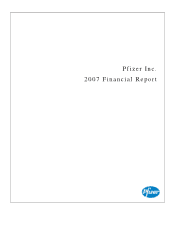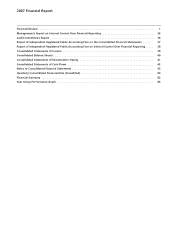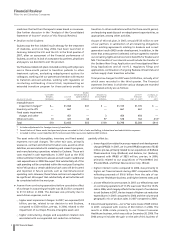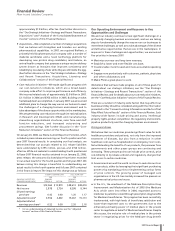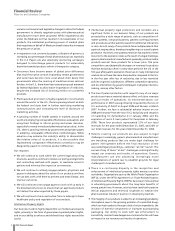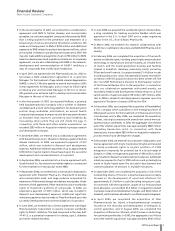Pfizer 2007 Annual Report Download - page 10
Download and view the complete annual report
Please find page 10 of the 2007 Pfizer annual report below. You can navigate through the pages in the report by either clicking on the pages listed below, or by using the keyword search tool below to find specific information within the annual report.
8 2007 Financial Report
Financial Review
Pfizer Inc and Subsidiary Companies
these new investments with savings from reduced spending on
support staff and facilities costs.
Pfizer Global Manufacturing (PGM)—
•Plant Network Optimization—To ensure that our manufacturing
facilities are aligned with current and future product needs, we
are continuing to optimize Pfizer’s network of plants. We have
focused on innovation and delivering value through a simplified
supply network. Since 2005, 30 sites have been identified for
rationalization. In addition, there have been extensive
consolidations and realignments of operations resulting in
streamlined operations and staff reductions.
We have reduced our network of plants from 93 four years ago
to 57 today, which also reflects the acquisition of seven plants
and the sites sold in 2006 as part of our Consumer Healthcare
business. By the end of 2009, we plan to reduce our network
of manufacturing plants around the world to 45. The cumulative
impact will be a more focused, streamlined and competitive
manufacturing operation, with less than 50% of our plants and
a reduction of 35% of our manufacturing employees compared
to 2003. Further, we currently outsource the manufacture of
approximately 17% of our products on a cost basis and plan to
increase this substantially by 2010 and beyond.
Worldwide Pharmaceutical Operations (WPO)—
•Field Force Realignment—To improve our effectiveness in and
responsiveness to the business environment, we have realigned
our European marketing teams and implemented productivity
initiatives for our field force in Japan. We completed the U.S.
reorganization in December 2006, which included a 20% reduction
in our U.S. field force. The restructured U.S. field force was
operational starting in April 2007 and productivity per sales
representative has returned to the levels before the reorganization,
retaining our competitiveness and share of voice. Globally, we have
reduced our field force by approximately 11%. Additional savings
are being generated from de-layering, eliminating duplicative
work and strategically realigning various functions.
We are in the process of transforming our field force operations
in Europe to being more customer-centric by reorganizing and
shifting resources. As of December 31, 2007, we had reduced
our field force in Europe by approximately 17% and expect total
reductions of 20% by the end of 2008, subject to consultation
with works councils and local labor law, while allowing us to
maintain a competitive voice for our medicines and a strong
organization going forward.
Information Technology—
•Reductions in Application Software—To achieve cost savings,
we have pursued significant reductions in application software
and data centers, as well as rationalization of service providers,
while enhancing our ability to invest in innovative technology
opportunities to further propel our growth. By consolidating
11 third-party providers and reducing labor costs, we expect to
generate considerable annual savings and improve service
quality.
Finance—
•Further Capitalizing on Shared Service Centers—To achieve
cost savings, we have reduced operating costs and improved
service levels by standardizing, regionalizing and/or outsourcing
a wide array of transactional accounting activities.
Global Sourcing—
•Leveraging Purchasing Power—To achieve cost savings on
purchased goods and services, we have focused on rationalizing
suppliers, leveraging our substantial purchases of goods and
services and improving demand management to optimize levels
of outside services needed and strategic sourcing from lower-
cost sources. For example, savings from demand management
are being derived in part from reductions in travel,
entertainment, consulting and other external service expenses.
Facilities savings are being found in site rationalization, energy
conservation and renegotiated service contracts.
Our Strategic Initiatives—Strategy and Recent Transactions
Acquisitions, Licensing and Collaborations
We are committed to capitalizing on new growth opportunities
by advancing our own new-product pipeline and maximizing
the value of our in-line products, as well as through opportunistic
licensing, co-promotion agreements and acquisitions. Our business
development strategy targets a number of growth opportunities,
including biologics, oncology, diabetes, Alzheimer’s disease,
cardiovascular disease, vaccines and other products and services
that seek to provide valuable healthcare solutions. Some of our
most significant business-development transactions since 2005 are
described below.
•In December 2007, we entered into a license agreement with
Scil Technology Gmbh (Scil) for worldwide collaboration on Scil
cartilage specific growth factor CD-RAP. Under this agreement,
Pfizer obtained a worldwide exclusive license to develop and
commercialize CD-RAP. In 2007, we expensed a payment of $8
million, which was included in Research and development
expenses. We may also make additional payments of up to $242
million based upon development and regulatory milestones.
•In December 2007, we entered into a license and collaboration
agreement with Adolor Corporation (Adolor) to develop and
commercialize ADL5859 and ADL577, proprietary delta opioid
receptor agonist compounds for the treatment of pain. In
2007, we expensed a payment of $32 million, which was
included in Research and development expenses. We may also
make additional payments of up to $233 million to Adolor,
based on development and regulatory milestones.
•In December 2007, we entered into a research collaboration and
license agreement with Taisho Pharmaceutical Co., Ltd. (Taisho)
to acquire worldwide rights outside of Japan for TS-032, a
metabolic glutamate receptor agonist that may offer a new
treatment option for central nervous system disorders, and is
currently in pre-clinical development for the treatment of
schizophrenia. In 2007, we expensed a payment of $22 million,
which was included in Research and development expenses. We
may also make additional payments of up to $265 million to
Taisho based upon development and regulatory milestones.

